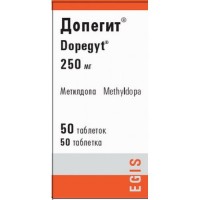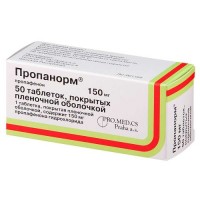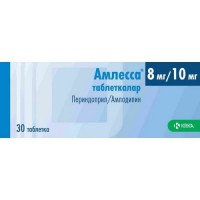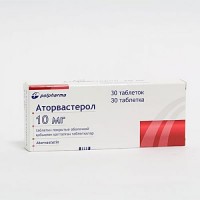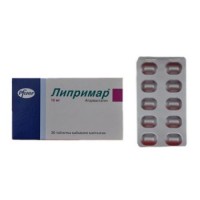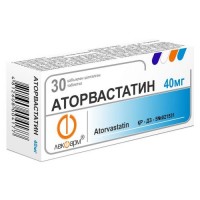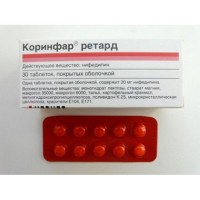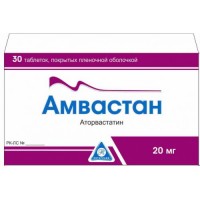Tricor 30s 145 mg film-coated tablets
- $51.60
The instruction
for medical use
of Tricor® medicine
the Trade name
of Tricor®
the International unlicensed
name Fenofibrat Lekarstvennaya
the Tablet form, film coated, 145 mg
Structure
One tablet contains
active agent – fenofibrat micronized 145 mg,
excipients: gipromelloza, sodium docusate, sucrose, sodium lauryl sulfate, lactoses monohydrate, cellulose microcrystalline silonizirovanny, krospovidon, magnesium stearate.
structure of a cover: Opadray OY-B-28920 (polyvinyl alcohol, the titan E171 dioxide, talc, lecithin from soybeans, gum xanthane).
The description
of the Tablet of an oval form, film coated white color, with an engraving 145 on one party and a logo of the company on other party.
Pharmacotherapeutic group
Hypolipidemic drugs. Gipokholesterinemichesky and gipotriglitseridemichesky drugs. Fibrata. Fenofibrat.
ATX C10AB05 code
the Pharmacological
Tricor Tablet Pharmacokinetics properties of 145 mg, film coated, contain 145 mg of the fenofibrat micronized in the form of nanoparticles.
Absorption. After intake of Tricor of 145 mg of Cmax (maximum concentration) of fenofibroyevy acid it is reached in 2-4 h. At prolonged use the concentration of fenofibroyevy acid in plasma remains stable, irrespective of specific features of the patient. Unlike the former wording of the fenofibrat, Cmax in blood plasma and systemic effect of the fenofibrat micronized in the form of nanoparticles (Tricor of 145 mg) does not depend on a concomitant use of food (therefore the drug can be taken at any time, irrespective of meal).
Distribution
of Fenofibroyevaya acid strongly and more than for 99% contacts plasma albumine.
Metabolism and removal
After intake fenofibrat is quickly hydrolyzed by esterases to fenofibroyevy acid which is its main active metabolite. In plasma fenofibrat it is not found. Fenofibrat is not substrate for CYP3A4, does not participate in microsomal metabolism in a liver.
Fenofibrat is brought, mainly, with urine in the form of fenofibroyevy acid and a conjugate of a glucuronide. During 6 days fenofibrat it is removed almost completely. At patients of advanced age the general clearance of fenofibroyevy acid does not change. Elimination half-life of fenofibroyevy acid (T1/2) - about 20 h. At a hemodialysis it is not removed. Kinetic researches showed what fenofibrat does not collect after single dose and at prolonged use.
A pharmacodynamics
Tricor - hypolipidemic means from group of derivatives of fibroyevy acid. Fenofibrat has ability to change the maintenance of lipids in an organism due to activation of receptors of PPAR-α (the alpha receptors activated by a proliferator of peroxisomas).
Fenofibrat strengthens a lipolysis and removal from plasma of atherogenous lipoproteins with the high content of triglycerides by activation of receptors of PPAR-α, lipoproteinlipase and reduction of synthesis of apoprotein C-III (apo C-III). The effects described above lead to reduction of maintenance of fraction of LDL and LPONP which include apoprotein B (apo C), and increase in maintenance of LPVP fraction which include A-I apoprotein (apo A-I) and A-II apoprotein (apo A-II). Besides, due to correction of disturbances of synthesis and catabolism of LPONP, fenofibrat increases clearance of LDL and reduces the maintenance of fine and dense particles of LDL (increase in these in LDL is observed at patients with an atherogenous phenotype of lipids and is followed by high risk of an ischemic heart disease).
During clinical trials it was noted that use of the fenofibrat reduces the level of general Hs by 20-25% and triglycerides for 40-55% at increase in the Hs-LPVP level for 10-30%. At patients with a hypercholesterolemia, at whom the Hs-LPNP level decreases by 20-35%, the use of the fenofibrat led to decrease in ratios: general Hs/Hs-LPVP, Hs-LPNP/Hs-LPVP and apo In / apo A-I which are markers of atherogenous risk.
There are proofs that fibrata can reduce the frequency of the events connected with coronary heart disease, but decrease in the general mortality at primary or secondary prevention of cardiovascular diseases is not proved.
During treatment fenofibraty can decrease considerably and even completely to disappear extravasated deposits of Hs (tendinous and tuberous xanthomas). At the patients with the increased level of fibrinogen who received treatment fenofibraty the considerable decrease in this indicator as well as at patients with the increased level of lipoproteids is noted. At treatment fenofibraty decrease in concentration of S-reactive protein and other markers of inflammation is observed.
For patients with a dislipidemiya and a hyperuricemia the additional benefit is in what fenofibrat renders uricosuric effect which leads to decrease in concentration of uric acid approximately by 25%.
During clinical trial it was shown what fenofibrat reduces the aggregation of thrombocytes caused by adenosinediphosphate, arachidonic acid and epinephrine.
Indications
In addition to a diet and other non-drug methods of treatment
(physical activity, weight reduction) at the following states:
- a heavy gipertriglitseridemiya with the low level of cholesterol of high density or without it
- the mixed lipidemia in the presence of contraindications or intolerance to statines
- the mixed lipidemia at patients with high cardiovascular risk in addition to statines at insufficient efficiency in correction of level of triglycerides and cholesterol of high density
the Route of administration and doses
take the Drug Tricor of 145 mg at any time, irrespective of meal, the tablet should be swallowed entirely, without chewing, washing down with a glass of water.
In a combination with a diet, Tricor 145 mg are appointed long courses which efficiency should be controlled periodically.
The therapeutic effectiveness is estimated by means of values of a lipidic range (general cholesterol, cholesterol of low density, triglycerides).
If within 3 months it is not reached improvement of indicators of a lipidic profile, it is necessary to consider the possibility of purpose of additional or alternative therapy.
The adult appoint on 1 tablet Tricor 145 mg of 1 times a day. The patients accepting 200 mg on 1 capsule of the fenofibrat can pass to reception 1 tablets Tricora of 145 mg a day without additional dose adjustment.
The patients accepting on one tablet of the fenofibrat 160 mg a day can pass to reception 1 tablets Tricora of 145 mg without additional correction of a dose.
Patients of advanced age without renal failure are recommended to appoint a standard dose for adults.
Use of drug for patients with diseases of a liver is not studied.
Side effects
during placebo of controlled clinical trials (n=2344) were observed the following undesirable effects:
Often
- an abdominal pain, nausea, vomiting, diarrhea, a meteorism (moderate)
- increase in level of transaminases of a liver
Infrequently
- a headache
- a deep vein thrombosis, a pulmonary embolism
- pancreatitis
- a cholelithiasis
- skin reactions of hypersensitivity: rash, an itching, urticaria
- myalgia, a miositis, muscular spasms, muscle weakness
- sexual dysfunction
- increase in level of creatinine in blood
Is rare
- decrease in level of hemoglobin, decrease in maintenance of leukocytes
- hypersensitivity
- hepatitis
- an alopecia, reactions of a photosensitization
- increase in level of urea in blood plasma
- feeling of fatigue, dizziness
the Side effects revealed during postmarketinovy use (frequency is unknown):
- interstitial pneumopathies
- a rhabdomyolysis
- jaundice, cholelithiasis complications (e.g., cholecystitis, a cholangitis, bilious colic)
- heavy skin reactions (for example, a mnogoformny erythema, Stephens-Johnson's syndrome, a toxic epidermal necrolysis)
Contraindications
- hypersensitivity to active or any auxiliary component of drug
- a liver failure (including cirrhosis and persistent disturbances of a liver of not clear etiology)
- a renal failure of heavy degree (KK & lt, 20 ml/min.)
- diseases of a gall bladder
- chronic or acute pancreatitis except for acute pancreatitis owing to a heavy gipertriglitseridemiya
- a congenital galactosemia, insufficiency of lactase, disturbance of absorption of glucose and a galactose (drug contains lactose)
- a congenital fruktozemiya, insufficiency of invertase-isomaltase (drug contains sucrose)
- existence in the anamnesis of allergic reaction to peanut, peanut butter, soy lecithin or related products (in connection with risk of development of reaction of hypersensitivity)
- existence in the anamnesis of a photosensitization or phototoxicity at treatment of a fibratama or ketoprofen
- children's and teenage age up to 18 years
- pregnancy and the period of a lactation (breastfeeding)
Medicinal interactions
is not recommended to appoint Oral anticoagulants along with Tricory 145 mg. Fenofibrat enhances effect of oral anticoagulants and can increase risk of bleedings that it is connected with replacement of anticoagulant from places of linking with proteins of blood plasma. In an initiation of treatment fenofibraty it is recommended to lower a dose of anticoagulants approximately on a third with the subsequent gradual selection of a dose. Selection of a dose is recommended to be carried out under control of level of the International Normalized Relation (MHO).
Cyclosporine. Several hard cases of reversible decrease
in renal function are described during simultaneous treatment fenofibraty and cyclosporine. Therefore it is necessary to control a condition of renal function at such patients and to cancel Tricor 145 mg in case of serious change of laboratory parameters.
Ko-and inhibitors of reductase and other fibrata. At reception of the fenofibrat along with inhibitors of GMG-KoA-reduktazy or other fibrata the risk of serious toxic impact on muscle fibers increases. With care to use drugs of this group from Tricory 145 mg, patients need careful observation regarding emergence by sign of muscular toxicity.
Researches of microsomes from a liver of the person of in vitro showed that fenofibrat and fenofibroyevy acid are not inhibitors of isoenzymes CYP3A4, CYP2D6, CYP2E1 or CYP1A2. In therapeutic concentration these connections are weak inhibitors of isoenzymes of CYP2C19 and CYP2A6 and weak or moderate CYP2C9 inhibitors. The patients applying fenofibrat together with medicines, metaboliziruyemy CYP2C19, CYP2A6 and especially CYP2C9 with the narrow therapeutic index have to be under careful observation and, if necessary, modify doses of these drugs.
Glitazona
Soobshchalos about cases of reversible paradoxical decrease in level of LPVP-cholesterol at combined use of the fenofibrat and glitazon. Thus, it is recommended to control LPVP cholesterol level at the combined prescribing of these drugs and to stop therapy at considerable decrease in LPVP cholesterol.
Special instructions
Before starting therapy of Tricory 145 mg, it is necessary to carry out the corresponding treatment for elimination of the reason of a secondary hypercholesterolemia, for example, in such diseases as uncontrollable diabetes of type 2, a hypothyroidism, a nephrotic syndrome, a disproteinemia, obstructive diseases of a liver, a consequence of medicamentous therapy, alcoholism.
It is necessary to find out from the patients with a lipidemia accepting the estrogen or hormonal contraceptives containing estrogen whether the lipidemia has primary or secondary nature. In such cases the increase in level of lipids can be caused by intake of estrogen.
The efficiency of therapy should be estimated on the maintenance of lipids (Hs, LDL, triglycerides) in blood serum. In the absence of therapeutic effect after several months of therapy (as a rule, after 3 months) it is necessary to consider expediency of purpose of the accompanying or alternative therapy.
Function of a liver: At Tricor's reception 145 mg and other drugs reducing concentration of lipids at some patients the increase in activity of hepatic transaminases is described. In most cases such increase was temporary, insignificant and asymptomatic. Within the first 12 months of treatment it is recommended to control the level of hepatic transaminases (ALT, ACT) every 3 month. Patients at whom against the background of treatment concentration of transaminases increased require special attention, and in case of increase in concentration of ALT and ACT more than by 3 times in comparison with the upper bound of norm (UBN) stop administration of drug. At emergence of symptoms of hepatitis (jaundice, an itching), it is necessary to carry out laboratory tests for its confirmation and to consider the possibility of the termination of reception of Tricor of 145 mg.
Pancreatitis: Cases of development of pancreatitis during treatment of Tricory 145 mg were described. The possible causes of pancreatitis in these cases were: insufficient efficiency of drug at patients with a heavy gipertriglitseridemiya, direct influence of drug and also the secondary phenomena connected with existence of the stones or formation of a deposit in a gall bladder which are followed by impassability of the general bile duct.
Toxic influence on muscle tissue: At reception of fibrat and other hypolipidemic means, cases of toxic influence on muscle tissue are described, including very exceptional cases of a rhabdomyolysis (with a renal failure or without). The possibility of this complication increases in cases of a hypoalbuminemia and a renal failure.
Toxic influence on muscle tissue can be suspected on the basis of complaints of the patient to weakness, diffusion myalgia, a miositis, muscular spasms and spasms and/or the significant increase in activity by KFK (more than by 5 times in comparison with VGN). In these cases Tricor 145 mg should be cancelled.
Risk of developing a rhabdomyolysis can increase at patients with predisposition to a myopathy and/or a rhabdomyolysis, including age 70 years, the burdened anamnesis on hereditary muscular diseases, a renal failure, a hypothyroidism, an alcohol abuse are more senior. Such patients should appoint drug only if the expected advantage exceeds possible risk of developing a rhabdomyolysis.
At a concomitant use with inhibitors of GMG-KoA-reduktazy or other fibrata the risk of serious toxic impact on muscle fibers, especially increases if the patient prior to treatment had a disease of muscles. In this regard, joint appointment of Tricor of 145 mg and statine is admissible only in the presence at the patient of the heavy mixed dislipidemiya and high cardiovascular risk, in the absence of a disease of muscles in the anamnesis and in the conditions of the fixed control directed to identification of signs of development of muscular toxicity.
Function of kidneys. In case of increase in concentration of creatinine the treatment more than 50% higher than VGN should be suspended. In the first 3 months of treatment
it is recommended to define concentration of creatinine.
Tricor of 145 mg contains lactose therefore to patients with rare congenital
pathology intolerance of a galactose, deficiency of Lappa lactase or malabsorption of glucose galactose it is not necessary to appoint this drug.
Tricor of 145 mg contains sucrose therefore to patients with rare congenital pathology intolerance of fructose, malabsorption of glucose galactose or insufficiency of invertase-isomaltase it is not necessary to appoint this drug.
The feature of influence of medicine on ability to run the vehicle or potentially dangerous mechanisms
At administration of drug of influence on ability to driving by the car and to control of mechanisms is not revealed.
Overdose
overdose Cases Tricor 145 mg are not described. Strengthening of severity of side effects is possible.
Treatment: carrying out symptomatic and, if necessary, maintenance therapy. Specific antidote is unknown. The hemodialysis is inefficient.
The form of release and packing
On 10 tablets place in blister strip packaging from a film of polyvinylchloride and aluminum foil.
On 3 planimetric packs together with the instruction for medical use in the state and Russian languages put in a cardboard box.
To Store storage conditions in original packing, at a temperature not above 25 °C.
To store out of children's reach!
3 years
not to apply a period of storage after an expiration date!
Prescription status
According to the prescription
the Producer Fournier of Irland Ltd. Laboratory, Ireland
Angruv, Karridvokhil Co. Cork
Retsifarm Organization packer of Fontaine, France
Rui, 21121, Fontaine Le Dijon
Owner of the registration certificate:
Abbott Laboratories GmbH, Germany
Frendale 9A, 30173, Hanover
the Address of the organization accepting in the territory of the Republic of Kazakhstan claims from consumers on quality of products (goods) of Abbott Kazakhstan LLP 050059 Almaty, Dostyk Avenue 117/6, Business center Han-Tengri-2, the Republic of Kazakhstan. Ph.: +7 727 2447544, Fax: +7 727 2447644. e-mail:
To develop pv.kazakhstan@abbott.com
for medical use
of Tricor® medicine
the Trade name
of Tricor®
the International unlicensed
name Fenofibrat Lekarstvennaya
the Tablet form, film coated, 145 mg
Structure
One tablet contains
active agent – fenofibrat micronized 145 mg,
excipients: gipromelloza, sodium docusate, sucrose, sodium lauryl sulfate, lactoses monohydrate, cellulose microcrystalline silonizirovanny, krospovidon, magnesium stearate.
structure of a cover: Opadray OY-B-28920 (polyvinyl alcohol, the titan E171 dioxide, talc, lecithin from soybeans, gum xanthane).
The description
of the Tablet of an oval form, film coated white color, with an engraving 145 on one party and a logo of the company on other party.
Pharmacotherapeutic group
Hypolipidemic drugs. Gipokholesterinemichesky and gipotriglitseridemichesky drugs. Fibrata. Fenofibrat.
ATX C10AB05 code
the Pharmacological
Tricor Tablet Pharmacokinetics properties of 145 mg, film coated, contain 145 mg of the fenofibrat micronized in the form of nanoparticles.
Absorption. After intake of Tricor of 145 mg of Cmax (maximum concentration) of fenofibroyevy acid it is reached in 2-4 h. At prolonged use the concentration of fenofibroyevy acid in plasma remains stable, irrespective of specific features of the patient. Unlike the former wording of the fenofibrat, Cmax in blood plasma and systemic effect of the fenofibrat micronized in the form of nanoparticles (Tricor of 145 mg) does not depend on a concomitant use of food (therefore the drug can be taken at any time, irrespective of meal).
Distribution
of Fenofibroyevaya acid strongly and more than for 99% contacts plasma albumine.
Metabolism and removal
After intake fenofibrat is quickly hydrolyzed by esterases to fenofibroyevy acid which is its main active metabolite. In plasma fenofibrat it is not found. Fenofibrat is not substrate for CYP3A4, does not participate in microsomal metabolism in a liver.
Fenofibrat is brought, mainly, with urine in the form of fenofibroyevy acid and a conjugate of a glucuronide. During 6 days fenofibrat it is removed almost completely. At patients of advanced age the general clearance of fenofibroyevy acid does not change. Elimination half-life of fenofibroyevy acid (T1/2) - about 20 h. At a hemodialysis it is not removed. Kinetic researches showed what fenofibrat does not collect after single dose and at prolonged use.
A pharmacodynamics
Tricor - hypolipidemic means from group of derivatives of fibroyevy acid. Fenofibrat has ability to change the maintenance of lipids in an organism due to activation of receptors of PPAR-α (the alpha receptors activated by a proliferator of peroxisomas).
Fenofibrat strengthens a lipolysis and removal from plasma of atherogenous lipoproteins with the high content of triglycerides by activation of receptors of PPAR-α, lipoproteinlipase and reduction of synthesis of apoprotein C-III (apo C-III). The effects described above lead to reduction of maintenance of fraction of LDL and LPONP which include apoprotein B (apo C), and increase in maintenance of LPVP fraction which include A-I apoprotein (apo A-I) and A-II apoprotein (apo A-II). Besides, due to correction of disturbances of synthesis and catabolism of LPONP, fenofibrat increases clearance of LDL and reduces the maintenance of fine and dense particles of LDL (increase in these in LDL is observed at patients with an atherogenous phenotype of lipids and is followed by high risk of an ischemic heart disease).
During clinical trials it was noted that use of the fenofibrat reduces the level of general Hs by 20-25% and triglycerides for 40-55% at increase in the Hs-LPVP level for 10-30%. At patients with a hypercholesterolemia, at whom the Hs-LPNP level decreases by 20-35%, the use of the fenofibrat led to decrease in ratios: general Hs/Hs-LPVP, Hs-LPNP/Hs-LPVP and apo In / apo A-I which are markers of atherogenous risk.
There are proofs that fibrata can reduce the frequency of the events connected with coronary heart disease, but decrease in the general mortality at primary or secondary prevention of cardiovascular diseases is not proved.
During treatment fenofibraty can decrease considerably and even completely to disappear extravasated deposits of Hs (tendinous and tuberous xanthomas). At the patients with the increased level of fibrinogen who received treatment fenofibraty the considerable decrease in this indicator as well as at patients with the increased level of lipoproteids is noted. At treatment fenofibraty decrease in concentration of S-reactive protein and other markers of inflammation is observed.
For patients with a dislipidemiya and a hyperuricemia the additional benefit is in what fenofibrat renders uricosuric effect which leads to decrease in concentration of uric acid approximately by 25%.
During clinical trial it was shown what fenofibrat reduces the aggregation of thrombocytes caused by adenosinediphosphate, arachidonic acid and epinephrine.
Indications
In addition to a diet and other non-drug methods of treatment
(physical activity, weight reduction) at the following states:
- a heavy gipertriglitseridemiya with the low level of cholesterol of high density or without it
- the mixed lipidemia in the presence of contraindications or intolerance to statines
- the mixed lipidemia at patients with high cardiovascular risk in addition to statines at insufficient efficiency in correction of level of triglycerides and cholesterol of high density
the Route of administration and doses
take the Drug Tricor of 145 mg at any time, irrespective of meal, the tablet should be swallowed entirely, without chewing, washing down with a glass of water.
In a combination with a diet, Tricor 145 mg are appointed long courses which efficiency should be controlled periodically.
The therapeutic effectiveness is estimated by means of values of a lipidic range (general cholesterol, cholesterol of low density, triglycerides).
If within 3 months it is not reached improvement of indicators of a lipidic profile, it is necessary to consider the possibility of purpose of additional or alternative therapy.
The adult appoint on 1 tablet Tricor 145 mg of 1 times a day. The patients accepting 200 mg on 1 capsule of the fenofibrat can pass to reception 1 tablets Tricora of 145 mg a day without additional dose adjustment.
The patients accepting on one tablet of the fenofibrat 160 mg a day can pass to reception 1 tablets Tricora of 145 mg without additional correction of a dose.
Patients of advanced age without renal failure are recommended to appoint a standard dose for adults.
Use of drug for patients with diseases of a liver is not studied.
Side effects
during placebo of controlled clinical trials (n=2344) were observed the following undesirable effects:
Often
- an abdominal pain, nausea, vomiting, diarrhea, a meteorism (moderate)
- increase in level of transaminases of a liver
Infrequently
- a headache
- a deep vein thrombosis, a pulmonary embolism
- pancreatitis
- a cholelithiasis
- skin reactions of hypersensitivity: rash, an itching, urticaria
- myalgia, a miositis, muscular spasms, muscle weakness
- sexual dysfunction
- increase in level of creatinine in blood
Is rare
- decrease in level of hemoglobin, decrease in maintenance of leukocytes
- hypersensitivity
- hepatitis
- an alopecia, reactions of a photosensitization
- increase in level of urea in blood plasma
- feeling of fatigue, dizziness
the Side effects revealed during postmarketinovy use (frequency is unknown):
- interstitial pneumopathies
- a rhabdomyolysis
- jaundice, cholelithiasis complications (e.g., cholecystitis, a cholangitis, bilious colic)
- heavy skin reactions (for example, a mnogoformny erythema, Stephens-Johnson's syndrome, a toxic epidermal necrolysis)
Contraindications
- hypersensitivity to active or any auxiliary component of drug
- a liver failure (including cirrhosis and persistent disturbances of a liver of not clear etiology)
- a renal failure of heavy degree (KK & lt, 20 ml/min.)
- diseases of a gall bladder
- chronic or acute pancreatitis except for acute pancreatitis owing to a heavy gipertriglitseridemiya
- a congenital galactosemia, insufficiency of lactase, disturbance of absorption of glucose and a galactose (drug contains lactose)
- a congenital fruktozemiya, insufficiency of invertase-isomaltase (drug contains sucrose)
- existence in the anamnesis of allergic reaction to peanut, peanut butter, soy lecithin or related products (in connection with risk of development of reaction of hypersensitivity)
- existence in the anamnesis of a photosensitization or phototoxicity at treatment of a fibratama or ketoprofen
- children's and teenage age up to 18 years
- pregnancy and the period of a lactation (breastfeeding)
Medicinal interactions
is not recommended to appoint Oral anticoagulants along with Tricory 145 mg. Fenofibrat enhances effect of oral anticoagulants and can increase risk of bleedings that it is connected with replacement of anticoagulant from places of linking with proteins of blood plasma. In an initiation of treatment fenofibraty it is recommended to lower a dose of anticoagulants approximately on a third with the subsequent gradual selection of a dose. Selection of a dose is recommended to be carried out under control of level of the International Normalized Relation (MHO).
Cyclosporine. Several hard cases of reversible decrease
in renal function are described during simultaneous treatment fenofibraty and cyclosporine. Therefore it is necessary to control a condition of renal function at such patients and to cancel Tricor 145 mg in case of serious change of laboratory parameters.
Ko-and inhibitors of reductase and other fibrata. At reception of the fenofibrat along with inhibitors of GMG-KoA-reduktazy or other fibrata the risk of serious toxic impact on muscle fibers increases. With care to use drugs of this group from Tricory 145 mg, patients need careful observation regarding emergence by sign of muscular toxicity.
Researches of microsomes from a liver of the person of in vitro showed that fenofibrat and fenofibroyevy acid are not inhibitors of isoenzymes CYP3A4, CYP2D6, CYP2E1 or CYP1A2. In therapeutic concentration these connections are weak inhibitors of isoenzymes of CYP2C19 and CYP2A6 and weak or moderate CYP2C9 inhibitors. The patients applying fenofibrat together with medicines, metaboliziruyemy CYP2C19, CYP2A6 and especially CYP2C9 with the narrow therapeutic index have to be under careful observation and, if necessary, modify doses of these drugs.
Glitazona
Soobshchalos about cases of reversible paradoxical decrease in level of LPVP-cholesterol at combined use of the fenofibrat and glitazon. Thus, it is recommended to control LPVP cholesterol level at the combined prescribing of these drugs and to stop therapy at considerable decrease in LPVP cholesterol.
Special instructions
Before starting therapy of Tricory 145 mg, it is necessary to carry out the corresponding treatment for elimination of the reason of a secondary hypercholesterolemia, for example, in such diseases as uncontrollable diabetes of type 2, a hypothyroidism, a nephrotic syndrome, a disproteinemia, obstructive diseases of a liver, a consequence of medicamentous therapy, alcoholism.
It is necessary to find out from the patients with a lipidemia accepting the estrogen or hormonal contraceptives containing estrogen whether the lipidemia has primary or secondary nature. In such cases the increase in level of lipids can be caused by intake of estrogen.
The efficiency of therapy should be estimated on the maintenance of lipids (Hs, LDL, triglycerides) in blood serum. In the absence of therapeutic effect after several months of therapy (as a rule, after 3 months) it is necessary to consider expediency of purpose of the accompanying or alternative therapy.
Function of a liver: At Tricor's reception 145 mg and other drugs reducing concentration of lipids at some patients the increase in activity of hepatic transaminases is described. In most cases such increase was temporary, insignificant and asymptomatic. Within the first 12 months of treatment it is recommended to control the level of hepatic transaminases (ALT, ACT) every 3 month. Patients at whom against the background of treatment concentration of transaminases increased require special attention, and in case of increase in concentration of ALT and ACT more than by 3 times in comparison with the upper bound of norm (UBN) stop administration of drug. At emergence of symptoms of hepatitis (jaundice, an itching), it is necessary to carry out laboratory tests for its confirmation and to consider the possibility of the termination of reception of Tricor of 145 mg.
Pancreatitis: Cases of development of pancreatitis during treatment of Tricory 145 mg were described. The possible causes of pancreatitis in these cases were: insufficient efficiency of drug at patients with a heavy gipertriglitseridemiya, direct influence of drug and also the secondary phenomena connected with existence of the stones or formation of a deposit in a gall bladder which are followed by impassability of the general bile duct.
Toxic influence on muscle tissue: At reception of fibrat and other hypolipidemic means, cases of toxic influence on muscle tissue are described, including very exceptional cases of a rhabdomyolysis (with a renal failure or without). The possibility of this complication increases in cases of a hypoalbuminemia and a renal failure.
Toxic influence on muscle tissue can be suspected on the basis of complaints of the patient to weakness, diffusion myalgia, a miositis, muscular spasms and spasms and/or the significant increase in activity by KFK (more than by 5 times in comparison with VGN). In these cases Tricor 145 mg should be cancelled.
Risk of developing a rhabdomyolysis can increase at patients with predisposition to a myopathy and/or a rhabdomyolysis, including age 70 years, the burdened anamnesis on hereditary muscular diseases, a renal failure, a hypothyroidism, an alcohol abuse are more senior. Such patients should appoint drug only if the expected advantage exceeds possible risk of developing a rhabdomyolysis.
At a concomitant use with inhibitors of GMG-KoA-reduktazy or other fibrata the risk of serious toxic impact on muscle fibers, especially increases if the patient prior to treatment had a disease of muscles. In this regard, joint appointment of Tricor of 145 mg and statine is admissible only in the presence at the patient of the heavy mixed dislipidemiya and high cardiovascular risk, in the absence of a disease of muscles in the anamnesis and in the conditions of the fixed control directed to identification of signs of development of muscular toxicity.
Function of kidneys. In case of increase in concentration of creatinine the treatment more than 50% higher than VGN should be suspended. In the first 3 months of treatment
it is recommended to define concentration of creatinine.
Tricor of 145 mg contains lactose therefore to patients with rare congenital
pathology intolerance of a galactose, deficiency of Lappa lactase or malabsorption of glucose galactose it is not necessary to appoint this drug.
Tricor of 145 mg contains sucrose therefore to patients with rare congenital pathology intolerance of fructose, malabsorption of glucose galactose or insufficiency of invertase-isomaltase it is not necessary to appoint this drug.
The feature of influence of medicine on ability to run the vehicle or potentially dangerous mechanisms
At administration of drug of influence on ability to driving by the car and to control of mechanisms is not revealed.
Overdose
overdose Cases Tricor 145 mg are not described. Strengthening of severity of side effects is possible.
Treatment: carrying out symptomatic and, if necessary, maintenance therapy. Specific antidote is unknown. The hemodialysis is inefficient.
The form of release and packing
On 10 tablets place in blister strip packaging from a film of polyvinylchloride and aluminum foil.
On 3 planimetric packs together with the instruction for medical use in the state and Russian languages put in a cardboard box.
To Store storage conditions in original packing, at a temperature not above 25 °C.
To store out of children's reach!
3 years
not to apply a period of storage after an expiration date!
Prescription status
According to the prescription
the Producer Fournier of Irland Ltd. Laboratory, Ireland
Angruv, Karridvokhil Co. Cork
Retsifarm Organization packer of Fontaine, France
Rui, 21121, Fontaine Le Dijon
Owner of the registration certificate:
Abbott Laboratories GmbH, Germany
Frendale 9A, 30173, Hanover
the Address of the organization accepting in the territory of the Republic of Kazakhstan claims from consumers on quality of products (goods) of Abbott Kazakhstan LLP 050059 Almaty, Dostyk Avenue 117/6, Business center Han-Tengri-2, the Republic of Kazakhstan. Ph.: +7 727 2447544, Fax: +7 727 2447644. e-mail:
To develop pv.kazakhstan@abbott.com

